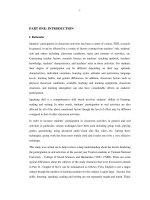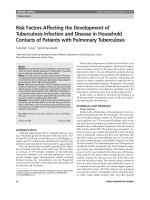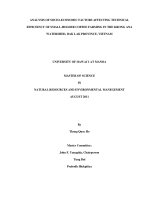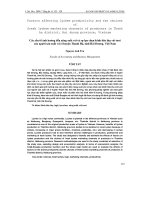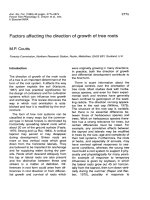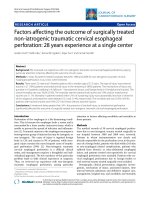Push-pull network: Factors affecting the migration of Laotian workers to Udon Thani, Thailand
Bạn đang xem bản rút gọn của tài liệu. Xem và tải ngay bản đầy đủ của tài liệu tại đây (649.04 KB, 10 trang )
PUSH-PULL NETWORK: FACTORS AFFECTING THE MIGRATION
OF LAOTIAN WORKERS TO UDON THANI, THAILAND
Mr. Thawatchai Sangseema
Department of Social Development, Faculty of Humanities and Social Science,
KhonKaen University, Thailand
E-mail:
Assistant Professor Dr.Thanapauge Chamaratana
Development of Social Development, Faculty of Humanities and Social Science,
KhonKaen University, Thailand
E-mail:
Abstract
The tendency of migration of Lao workers to Thailand is likely to increase especially
migration pattern is social network. The objective of this research was to study factors
effecting the migration through social network of Lao workers in Udon Thani. Qualitative
research method was applied in the study. Unit of analysis was group level. In-depth interview
guideline was applied to collect data from 15 Laotian workers the research site was Udon
Thani province, and together with participatory observation and non-participatory
observation. The ATLAS.ti programme was applied to categorize data, and data analysis was
based on the content analysis method. The research results showed that the crucial push
factors which contributed migration among Laotian workers included Udon Thani
Unemployment in residency, and low revenue in residency and important pull factors include
higher compensation, worker demand of establishments in Udon Thani province, Laotian
employers' values in Udon Thani, and social network of Laotian workers in destination.
Keywords: Social Network, Migration, Push factors, Pull factors, Laotian workers
1. Introduction
Labour migration is a global phenomenon which has been observed over the world.
Tendency of labour migration has been increasing due to the development of socioeconomics and advancement of technology (IMU, 2008). In Southeast Asia, labour
migration occurs due to a different rate of economic development in ASEAN countries.
Burma is the country where send the most workers to destination countries, followed by
Indonesia, Laos, Malaysia, Thailand, the Philippines, and Vietnam respectively. While
Brunei, Singapore, Malaysia, and Thailand are counted as the destination country. It is to
say that labour migration in Southeast Asian Region is an output of economic development
of ASEAN countries (Chamaratana, 2016)
Thailand has been considered as origin country and destination country
(Chamaratana et al, 2554), since economic change of Thailand in past decades boosted
economic growth in Thailand. A huge number of development project has been settled up
299
in Thailand especially development project on infrastructure facilities and industrial sector.
Those conditions has caused the flow of labour migration in Thailand. In addition,
Thailand currently is becoming the aging society, and it resulted in a decrease of workingaged people. In addition, the working-aged people seems not to work as workers due to
higher education they received. This circumstance tends to be contrast with current
country‘s economic which is growing and need more unskilled workers to serve industry
(Kulkolkarn, 2010).
Udon Thani is a city located in northeastern region of Thailand. Udon Thani city
nowadays is growing rapidly due to the growth of economics. According to statistics of
Udon Thani Economics (2013), the provincial economic revenue of Udon Thani is 8.5
billion Baht (THB), GDP is 52,000 Baht/year, total loan is 6.3 billion, and total deposit of
4.9 billion. Economic growth rate is increasing 5 % comparing to year 2008, and 100%
comparing to year 2003 (The Udon Thani Provincial Office of The Comptroller General,
2013). A massive economic growth rate offers a huge number of employment slot in Udon
Thani However, it appears that number of unskilled workers in Udon Thani is insufficient
due to the fact that many Thai workers have their own lands so that they prefer doing
agriculture in their own lands to working in some unskilled jobs. These are reasons why
Udon Thani needs migrant workers to serve economic sector. (Thongyou and Ayuwat, 2005)
Udon Thani located 70 Kilometers away from Vient������������������������������������������������������������������������������������������������������������������������������������������������������������������������������������������������������������������������������������������������������������������������������������������������������������������������������������������������������������������������������������������������������������������������������������������������������������������������������������������������������������������������������������������������������������������������������������������������������������������������������������������������������������������������������������������������������������������������������������������������������������������������������������������������������������������������������������������������������������������������������������������������������������������������������������������������������������������������������������������������������������������������������������������������������������������������������������������������������������������������������������������������������������������������������������������������������������������������������������������������������������������������������������������������������������������������������������������������������������������������������������������������������������������������������������������������������������������������������������������������������������������������������������������������������������������������������������������������������������������������������������������������������������������������������������������������������������������������������������������������������������������������������������������������������������������������������������������������������������������������������������������������������������������������������������������������������������������������������������������������������������������������������������������������������������������������������������������������������������������������������������������������������������������������������������������������������������������������������������������������������������������������������������������������������������������������������������������������������������������������������������������������������������������������������������������������������������������������������������������������������������������������������������������������������������������������������������������������������������������������������������������������������������������������������������������������������������������������������������������������������������������������������������������������������������������������������������������������������������������������������������������������������������������������������������������������������������������������������������������������������������������������������������������������������������������������������������������������������������������������������������������������������������������������������������������������������������������������������������������������������������������������������������������������������������������������������������������������������������������������������������������������������������������������������������������������������������������������������������������������������������������������������������������������������������������������������������������������������������������������������������������������������������������������������������������������������������������������������������������������������������������������������������������������������������������������������������������������������������������������������������������������������������������������������������������������������������������������������������������������������������������������������������������������������������������������������������������������������������������������������������������������������������������������������������������������������������������������������������������������������������������������������������������������������������������������������������������������������������������������������������������������������������������������������������������������������������������������������������������������������������������������������������������������������������������������������������������������������������������������������������������������������������������������������������������������������������������������������������������������������������������������������������������������������������������������������������������������������������������������������������������������������������������������������������������������������������������������������������������������������������������������������������������������������������������������������������������������������������������������������������������������������������������������������������������������������������������������������������������������������������������������������������������������������������������������������������������������������������������������������������������������������������������������������������������������������������������������������������������������������������������������������������������������������������������������������������������������������������������������������������������������������������������������������������������������������������������������������������������������������������������������������������������������������������������������������������������������������������������������������������������������������������������������������������������������������������������������������������������������������������������������������������������������������������������������������������������������������������������������������������������������������������������������������������������������������������������������������������������������������������������������������������������������������������������������������������������������������������������������������������������������������������������������������������������������������������������������������������������������������������������������������������������������������������������������������������������������������������������������������������������������������������������������������������������������������������������������������������������������������������������������������������������������������������������������������������������������������������������������������������������������������������������������������������������������������������������������������������������������������������������������������������������������������������������������������������������������������������������������������������������������������������������������������������������������������������������������������������������������������������������������������������������������������������������������������������������������������������������������������������������������������������������������������������������������������������������������������������������������������������������������������������������������������������������������������������������������������������������������������������������������������������������������������������������������������������������������������������������������������������������������������������������������������������������������������������������������������������������������������������������������������������������������������������������������������������������������������������������������������������������������������������������������������������������������������������������������������������������������������������������������������������������������������������������������������������������������������������������������������������������������������������������������������������������������������������������������������������������������������������������������������������������������������������������������������������������������������������������������������������������������������������������������������������������������������������������������������������������������������������������������������������������������������������������������������������������������������������������������������������������������������������������������������������������������������������������������������������������������������������������������������������������������������������������������������������������������������������������������������������������������������������������������������������������������������������������������������������������������������������������������������������������������������������������������������������������������������������������������������������������������������������������������������������������������������������������������������������������������������������������������������������������������������������������������������������������������������������������������������������������������������������������������������������������������������������������������������������������������������������������������������������������������������������������������������������������������������������������������������������������������������������������������������������������������������������������������������������������������������������������������������������������������������������������������������������������������������������������������������������������������������������������������������������������������������������������������������������������������������������������������������������������������������������������������������������������������������������������������������������������������������������������������������������������������������������������������������������������������������������������������������������������������������������������������������������������������������������������������������������������������������������������������������������������������������������������������������������������������������������������������������������������������������������������������������������������������������������������������������������������������������������������������������������������������������������������������������������������������������������������������������������������������������������������������������������������������������������������������������������������������������������������������������������������������������������������������������������������������������������������������������������������������������������������������������������������������������������������������������������������������������������������������������������������������������������������������������������������������������������������������������������������������������������������������������������������������������������������������������������������������������������������������������������������������������������������������������������������������������������������������������������������������������������������������������������������������������������������������������������������������������������������������������������������������������������������������������������������������������������������������������������������������������������������������������������������������������������������������������������������������������������������������������������������������������������������������������������������������������������������������������������������������������������������������������������������������������������������������������������������������������������������������������������������������������������������������������������������������������������������������������������������������������������������������������������������������������������������������������������������������������������������������������������������������������������������������������������������������������������������������������������������������������������������������������������������������������������������������������������������������������������������������y unskilled workers were working in agricultural sector, but there were a huge
number of job available in service sector. Therefore, it was an opportunity for Lao migrant
workers to find job in Udon Thani city. Working in Udon Thani city was not difficult for
Lao migrant workers, since people in those two countries shared similar culture such as
language, tradition, etc. Moreover, Udon Thani city located not far from Thai-Lao border,
and there were convenient transportation system to serve people from two countries, such
as international bus or train.
Due to those reasons, it caused number of Lao migrant workers living in Udon
Thani city was higher than migrant workers from other GMS countries. Moreover,
304
employment demand in agricultural sector, service sector, and industrial sector are still
high, and it resulted in vary jobs available for Lao migrant workers, as Ms.Koy mentioned.
“Previously the shop I worked for was small. There were only two workers. Later, the
business was growing. The owner decided expanding the shop, and he needed more workers.
I then took my brother from Laos to work together” (interviewed November 29, 2017)
Economic growth in Udon Thani city caused more job positions, but domestic
workers could not support employment demand. Therefore, Lao migrant workers were
option for employers especially on the jobs that Thai workers considered as dirty job, hard
job, and low-paid job.
5.3.3. Employment trends on Lao worker among employers in Udon Thani city
Thai employers preferred Lao migrant workers to Thai workers because Lao
migrant workers would be diligent, and the wage was lower than Thai worker‘s wage.
Almost Lao migrant workers had only one purpose in Thailand. They wanted to make
money as much as they could. When they had enough money, they would back home and
started small business. Therefore, Lao migrant workers would work very hard to make
money. This was different from Thai workers. Thai workers had more chances to choose
jobs. They might change jobs immediately once they found new opportunity. This was
why labour shortage became a major issue in Udon Thani as Ms. C said.
“My boss said she don‘t want to hire Thai workers because Thai workers always
come to work late, and they have many requirement of working. They can‘t work hard. It‘s
different from Lao migrant workers.” (interviewed September 18, 2017)
Moreover, some Thai employers preferred hiring Lao migrant workers due to low
wage paid. Wage of Lao migrant workers was lower than Thai worker‘s wage. Employers
would like to recall Lao migrant workers, who were in their labour network, to work with
them again once labour shortage arose as Ms. A said.
“At that time the shop needed more workers. My employer asked me to work at his
shop again because I was ex-employee at his shop. We had a contact each other such as
Facebook, or Line. I had nothing to do in Laos, so I said okay. Another reason is; my boss
contact me directly. He said he really wanted me to work for him. I appreciated him‖
(interviewed September 18, 2017)
According to information above, it is concluded that Thai employers in Udon Thani
city, who had ever hired Lao migrant workers, preferred Lao migrant workers to Thai
workers. Moreover, there was an encouragement of migration among Lao migrant
workers. Lao migrant workers would be rewarded by Thai employers once they recruited
Lao migrant workers to work for Thai employers during labour shortage circumstance.
5.3.4. Social network of Lao migrant workers in Udon Thani city
Social network is another factor that influenced on migration. Lao migrant workers
used advantage from their own social network to help working in Udon Thani city. Social
network performed through kin relationship. Lao migrant workers normally convinced
305
their relative to work in Udon Thani city, and they would prepare travelling details for the
new comers as Ms. A mentioned.
“I allowed him to prepare my travelling. When he had completed everything, he and
I made appointment to go to Udon Thani. I asked him to pick me up at my house because I
never go to Udon Thani. He came to my house, and crossed the border. I worked
immediately when I arrived Udon Thani. He would introduce me to others, and advise me
to work‖ (interviewed September 18, 2017)
Social network is a mechanism to ensure that migration to work in Udon Thani city
would be smoothly. Lao migrant workers decided moving to work because they trusted
persons who were in social network, mostly were their relatives. Moreover, Lao migrant
workers would be safe if they came to work with their relatives. They would be safe from
human trafficking or exploitation.
Social network is another pull factor which influenced on migration. Social network
would have major impact on migrant workers, since most of social networks of Lao
migrant workers were relative each other, such as siblings, or close friends. This was a
reason why Lao migrant workers had confidence in migration, and they made a decision to
migrate easily.
In conclusion, both push factors and pull factors are influenced on migration of Lao
migrant workers. Push factors consist of unemployment in Lao PDR, and low income in
Lao PDR. While pull factors consist of higher income in Udon Thani city, worker demand
in Udon Thani city, and employment trends among Thai employers. Thai employers prefer
Lao migrant workers to Thai workers because Lao migrant workers are diligent, and they
share similar culture such as language. In addition, the wage paid to Lao migrant workers
is lower than Thai worker‘s wage, and social network is a mechanism to ensure safety
during they are working in Udon Thani city.
6. Conclusion and Recommendation
Push factors that influenced on migration of Lao worker consist of two causes
including 1) unemployment in Lao PDR, and 2) low income in Lao PDR. This result is
supported by Suwicha (2008), Laosai (2012), and Wannahong (2016) who suggested that
push factors of migration in Laos are poverty and high unemployment rate in Laos. Those
migrants are considered as surplus labour who are not able to find jobs in Laos. While pull
factors consist of conditions including 1) higher income in Udon Thani city, 2) worker
demand in Udon Thani city, 3) employment trends among Thai employers, and 4) social
network of Lao migrant workers in Udon Thani city. These conditions are supported by
Suwicha (2008), and JungJing (2016) who suggested that high employment wage in
Thailand is a priority that convinces Lao migrant workers come to work in Thailand, while
employment availability and social network are important as well. Wannahong (2016) also
suggested that decision of migrating to Thailand has been made easily when Lao migrant
workers have their networks at destination country. Friend, neighbors, or relatives who
have moved to Thailand earlier would facilitate the new comers, and encourage them to
live in Thailand smoothly.
306
The research result show that effect from social network contribute to the decision
to migrate more. So that, Department of employment ministry of labour,Thailand
deserving has measures receive migration from social network. When it was discovered
that Laotian migrant workers has migration with relatives who used tourist passports to
doubt beforehand that is migrating to work. And signing a letter of intent to work and then
came the registration of labor later.
7. Acknowledgments
This research is a part of thesis Master of Arts social development faculty
humanities and social science Khon Kean University entitle ―Chain Migration through the
Social network of Laotian Migrants Labourers in Udon Thani province, Thailand‖. This
thesis was funded form the Research and Training Center for Enhancing Quality of Life of
Working Age People, Faculty of nursing, Khon Kean University, Thailand. Research
dissemination are supporting by Faculty of Humanities and Social Sciences, Khon Kaen
University, Thailand.
8. Reference
1. Achawanichakul, K. (1997). Synthesis situation transnational and policy
choice Importers of migrant workers of Thailand. Bangkok : Siam city.
2. Achawanichakul, K. and Wajanasara, K. (2008). Employment of migrant
workers under the Working of Aliens Act 2008 and the list of occupations allowed to
foreigners. Nakhon Pathom: Institude for population and social research Mahidol
University.
3. Appleyard, R.T. (1992). Migration and development: a global agenda for the
future. International Migration. 1(30), 17-32.
4. Chamaratana T, Ayuwat D, Knippenberg L, and Jong E.D. (2010). Connecting
the Disconnected: Background, practices and motives of labour brokers in Isan, Thailand an explorative study. The International Journal of Interdisciplinary Social Sciences.
5(5), 359-372.
5. Chamaratana T. (2011). Social network construction of Isan labour brokers.
Khon Kean: Thesis for the degree of doctor of philosophy in social science Khon Kean
University.
6. (2016). Working Among ―Thai - Aus‖: Social Networks of Thai Migrant
Labourers in Australia. Journal of Humanities and Social Sciences, SRU. 8(3), 267-289.
7. Chamaratana T, Ayuwat D, and Chinsri O. (2011). Connecting the disconnected:
social network of Isan labour workers. Journal of Mekong Societies. 7(3), 27-51.
8. (2011). Plural Characteristics of Social Network of. Isan Labor Brokers.
Kasetsart Jaurnal and Social science. 34(1), 1-16.
9. Jungjing, R. (2016). Guidelines and roles to sove health problems of Laos
migrant workers in factory, Khon Kaen Province. Thesis for the degree of Master of
Arts social development. Graduate school Khon Kean University.
10. Kulkolkarn, K. (2010). Effect of migrant workers to Thai workers Movement
and Production industry in Thailand. Bangkok: The Thailand research fund.
307
11. Laosai, S. (2012). Access to Help Services of Burmese Migrant Workers in
Indrustrial Factories in Khon Kean Province. Thesis for the degree of Master of Arts
social development. Graduate school Khon Kean University.
12. Lee Everette S. (1966). “A Theory of Migration” Reprinted in J.A. Jackson
(ed.) Migration. Cambridge: Cambridge University Press.
13. Nirathron, N. (2000). Networking: Some Considerations. Bangkok :
International project of problem-solving Child labourer. International Organization
14. Niyomna, P. et al. (2009). Study patterns network management of Social
Welfare Fund in Amphoe level Case study in Rasi Salai amphoe, Srisaket Province.
Nakhon Ratchasima: Ministry of Social Development and Human Security.
15. Polpanadham, P. et al. (2010). Social network promoting tourism at
Bangnoi float market, Bangkhonthi,. Samut Songkhram Province. Bangkok: Suan
Sunandha Rajabhat University.
16. Suwicha, K. (2008). The access to health services of Lao service workers:
the case study of amphur srichiangmai Nongkhai Province. Thesis for the degree of
Master of Arts social development. Graduate school Khon Kean University.
17. Thongyu M, and Ayuwat D. (2005). Social network of Lao transinational
migrant workers in Thailand. Journal of Mekong societies. 1(2), 55-86.
18. Wannahong, J. (2016). Social Network Construction of Lao Female
Migrant Workers in Udon Thani Province, Thailand. Thesis for the degree of Master of
Arts social development. Graduate school Khon Kean University.
308
